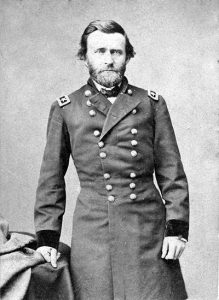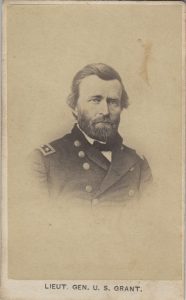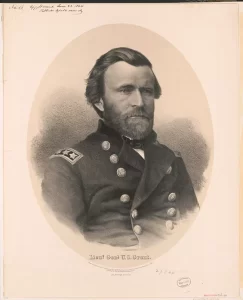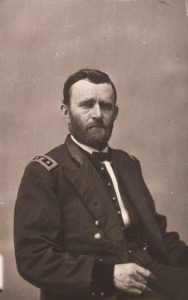Civil War Surprises: Dropping In On General Grant
I have recently been reading through the manuscript of sculptor James E. Kelly’s memoirs, which have never been published in their entirety. [1] They contain more than a few surprises, though one came to mind immediately when ECW’s Sarah Kay Bierle asked if I could contribute a story to this series.
The passage is taken from one of several interviews Kelly conducted with celebrated Civil War photographer Mathew Brady:
Talking of [Ulysses S.] Grant, then in about the last year of his life, and whom I had met, sketched and modeled, I asked Brady if he had any good pictures of the General. Putting his hand in his breast pocket, he pulled out a packet of photographs about an inch thick and handed them to me, saying, “Here are some I brought on from Washington.’ They included several of the finest specimens, and particularly one showing Grant standing in front of his head-quarters at the Wilderness, Virginia.
Continuing he said:
“Stanton wanted to be the next President. They thought if McClellan took Richmond, the Democrats would have the country for the next twenty years; but thought they could manipulate Grant. When he came on to the East in the early spring of 1864, and the new Commander-in-Chief of the Army, they did not want to make too much of him or plan to give him any reception. Stanton did not go himself with a carriage, or even send an Adjutant.”
“I remember one morning some newspaper men came to me and said that Grant was coming the next day on the 4 o’clock train. They asked me if I knew him. I said ‘only through correspondence,’ and then they asked me if I would know the General by sight. I answered, ‘Why, certainly I would.’ So we started around to the depot, when a few soldiers were scattered about. We got the together and had them go through the form of a reception, giving salutes, etc.”
“In a few minutes the train came in, and we saw a man with a slouch hat put his head out of the window. ‘That’s Grant!’ they said. ‘It is not!’ I replied. The man we noticed immediately pulled in his head, and in a few moments out came two men with slouch hats; both stooped and had shaggy beards. ‘That’s Grant!’ said I, as I jumped up and introduced myself, ‘General Grant, my name is Brady—do you know me?’ ‘Oh, yes, the photographer,’ he said.”
‘Have you decided where you are to go?’
‘No, I haven’t thought of that.’
‘Well, Willard’s is the military headquarters—what do you say to going there?’
‘Very well.’
‘Had I better order a carriage?’
‘I guess you had better.’
“So I ordered a carriage for him and Rawlins, then took another, and we all got in and drove ahead. There was a terrible crowd when we reached Willard’s; Gen. Sykes and other prominent officers were there. Before leaving, I told him that I wanted him to come to my place and be photographed.”
“‘Well I tell you, Brady,’ he said, ‘I have to see the President and the Secretary of War tomorrow, but as soon as I get through, I will come. I cannot appoint any time, but will be there.’ Next day I thought they would come about 2 o’clock, so had three cameras ready and man behind a screen to take as to color, etc., and waited for him. We waited all afternoon, until I was all worked up. It was a short day, the light began to fade and I was all fagged out. I said, ‘Well, we might as well give up—he is not coming.’”
“Just then a carriage drove up. The boy said, ‘There’s a general getting out, and there’s a man with him—I think it’s Stanton!’ I told them, ‘That’s he—prepare your plates, and I will take the risk.’ It was Stanton and Grant. He came in and they began to fire at him. The light had faded still more, and I had a skylight which, when I was engaged on portraits, was kept partly covered. The skylight was a heavy glass plate about 3/4ths of an inch thick. On account of the failing light, I sent one of the men to the remove the canvas.”
“He was a clumsy Dutchman, and as we were talking, there was a crash, and down came that heavy glass in a shower all around us—pieces as large as your hand, of all triangular shapes, cutting and smashing everything, and sticking in the table and floor. Stanton jumped up and grabbed me, his face as white as a sheet. Pulling me into a little room, he said, ‘Not a word of this! They will think it is a conspiracy—it must be kept quiet!’ Looking up we could see the legs and arms of the Dutchman hanging down.”
“‘How did Grant act?” I asked. “He never moved,” said Brady—“not a muscle; his face was firm and unconcerned. He gave that slight sneer with his nose, and looked as if nothing had happened.’
‘Did the glass hit near him?’
‘Yes, all around him—it cut the table cloth at his side and stuck in the floor; any one of those pieces might have gone through his skull. We brushed him off, and he went through the sittings as if nothing had happened, no more than as if a little dust had blown by.’
‘Have you any portrait of that sitting?’ I asked. ‘I think that is the one,’ replied Brady, pointing to a photograph of Grant in a copy of Harper’s Weekly I had laid out. Referring to the General’s quiet manner, I told him how freely Grant had talked to me. ‘Did you get him talking?’ inquired the veteran photographer laughingly, and then asked, ‘When he did talk, wasn’t he a rattler?’”
I have not been able to determine which portrait of Grant is the most likely to have been taking on the day when, in the style of Chicken Little, the sky started to fall. Brady’s insistence on Grant’s cool-headedness certainly fits within the general’s personality — and suggests that the man who led the Union to victory was very difficult to surprise.
Some possible portraits of the sitting mentioned follow, though I would welcome reader suggestions for the likely version!
Notes:
[1] William B. Styple self-published published selections and excerpts from the memoirs as Generals in Bronze in 2005.




What of the usual account of Grant showing up at Willard’s accompanied by only his son? Was Brady, perhaps, overstating his involvement?
In addition to 13 year-old Fred, Grant travelled with this Chief of Staff, John Rawlins and another staff officer, Cyrus Comstock … i am not sure where those officers stayed — could have been the Williard — but Grant’s biographers indicate it was just the General and Fred who checked in on the afternoon of 8 March ’64 … so, i think Brady got that right … whether or not they went to the Willard based on Brady’s recommendation might be up for debate … hard for me believe that Rawlins — an absolute stickler for details — would allow his general to show up in DC for his three promotion without deciding where the Grant and his son would stay.
This reminds me of a similar incident in August 1864. Grant was sitting with his staff in front of the headquarters tent at the huge City Point supply base on the James, when, according to Lt. Col. Horace Porter Porter, “a terrific explosion shook the earth” very like the recent Petersburg mine. “Then there rained down upon the party a terrific shower of shells, bullets, boards, and fragments of timber.” A Confederate saboteur had snuck into the base and planted a time bomb on an ammunition barge below the bluff where they were sitting. The blast discharged 30,000 artillery shells and 75,000 small arms rounds, vaporized the barge and all aboard, triggered the next barge, flattened the adjoining warehouse, and destroyed over half of the 400-foot wharf. A mounted orderly and several horses died instantly; a staff member and three orderlies were wounded. Debris flew half a mile in every direction. Porter: “The general was the only one of the party who remained unmoved; he did not even leave his seat to run to the bluff with the others to see what had happened.” (“Grant’s Lifeline: City Point, Virginia” in “Grant vs. Lee, Favorite Stories and Fresh Perspectives from the Historians at Emerging Civil War” (Savas Beatie 2022))
Wow, what a wonderful find! Just to read a first-hand account of this incident sounds so detailed and personal…..so much more so than from a book. Thank you.
Isn’t it Mathew?
Just wonderful. Brady is so underwritten about–
based on zero primary source evidence, i am going with the first pic on the left as the Brady portrait from 9 March 1864, the date President Lincoln promoted Grant to lieutenant general … i picked that one because Grant is clearly thinner and youthful than the beefier, more careworn gent in the pics to the right … that appearance comports with a year’s worth of hard campaigning in the west during most of 1863 when Grant’s diet likely wasn’t much better then his troops.
And while not a huge deal, Brady either forgot or left a few things out of his story … Grant, his staff and son Fred arrived in DC on the afternoon of 8 March … before going to the Willard Hotel, Grant attempted to make a courtesy call on Major General Halleck at the War Department … Halleck wasn’t there so they tried his home in Georgetown … again, no Halleck so the party checked at Willard and had dinner where Grant was recognized by other guests … later that evening, Grant met with the President in the Whitehouse … he returned the next day to be promoted to three star and was apparently photographed by Brady that afternoon … Brady leaves out the part about the Halleck visit, stating they went directly the hotel … he also states that Grant stayed at the Williard based on his recommendation … while that’s possible, it’s unlikely as Grant’s staff would have made those arrangements prior to leaving for DC.
thanks for this great little nugget about Brady — very cool.